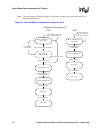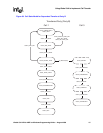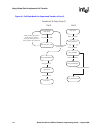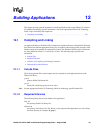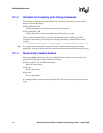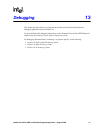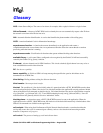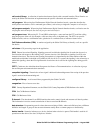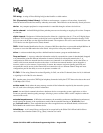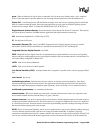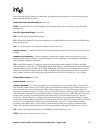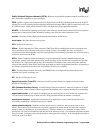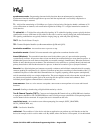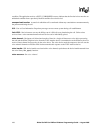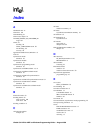
144 Global Call API for HMP on Windows Programming Guide — August 2006
call control library: A collection of routines that interact directly with a network interface. These libraries are
used by the Global Call functions to implement network specific commands and communications.
call progress: When using Intel NetStructure
®
Digital Network Interface boards, a term that describes the
activity that occurs before a call is connected (pre-connect), such as busy or ringback. Compare to call analysis.
call progress analysis: When using Intel NetStructure
®
Digital Network Interface boards, a collective term for
call progress and call analysis. See also call progress and call analysis.
call progress tone: When using E1, T1 and ISDN technologies, a tone sent from the PTT to tell the calling
party the progress of the call, (for example, a dial tone, busy tone, or ringback tone). The PTT's can provide
additional tones, such as a confirmation tone, splash tone or a reminder tone, to indicate a feature in use.
Call Reference Number (CRN): A number assigned by the Global Call library to identify a call on a specific
line device.
call states: Call processing stages in the application.
CAS: Channel Associated Signaling. Signaling protocols in which the signaling bits for each time slot are in a
fixed location with respect to the framing. In E1 systems, time slot 16 is dedicated to signaling for all 30 voice
channels (time slots). The time slot the signaling corresponds to is determined by the frame number within the
multiframe and whether it's the high or low nibble of time slot 16. In T1 systems, the signaling is also referred to as
robbed-bit signaling, where the least significant bit of each time slot is used for the signaling bits during specific
frames.
CEPT: Conference des Administrations Europeenes des Postes et Telecommunications. A collection of groups
that set European telecommunications standards.
compelled signaling: Transmission of next signal is held until acknowledgement of the receipt of the previous
signal is received at the transmitting end.
configured library: A call control library supported by the Global Call API.
congestion: Flow of user-to-user data
CDP: Country Dependent Parameter; see the Global Call Country Dependent (CDP) Reference for details.
CRN: See Call Reference Number.
CRV: Call Reference Value
D channel: The data channel in an ISDN interface that carries control signals and customer call data in packets.
This information is used to control transmission of data on associated B channels.
data structure: Programming term for a data element consisting of fields, where each field may have a different
definition and length. A group of data structure elements usually share a common purpose or functionality.
device handle: Numerical reference to a device, obtained when a device is opened. This handle is used for all
operations on that device. See also Call Reference Number.



